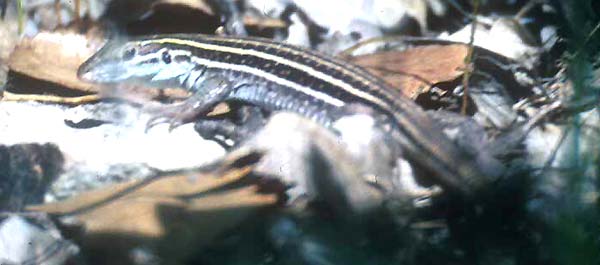

 Lean and fast, whiptails are hard to catch and harder still to photograph!
They are quite common in many places in the state, but these are my best
efforts to date. There are only two species of whiptail in California:
the one shown here is the widespread Tiger (or Western)
Whiptail Cnemidophorus tigris. Three subspecies are recognized
in California: California Whiptail C. t. mundus in the coastal ranges
and Central Valley south to about Los Angeles Co. (above; a photo from
Monterey Co.); Great Basin Whiptail C. t. tigris of the high and
low deserts (left; a photo from Inyo Co.); and Coastal Whiptail C. t.
stejnegeri of the coastal range south of Los Angeles Co. Both the lizards
shown here have nice tiger-bars on the sides, turning to spots up on the
neck. The races differ in the intensity of back striping. Although subject
to individual variation, the Great Basin Whiptail is well-striped while
the coastal range whiptails (both the Coastal and the California whiptails)
have the back stripes obscured by brown.
Lean and fast, whiptails are hard to catch and harder still to photograph!
They are quite common in many places in the state, but these are my best
efforts to date. There are only two species of whiptail in California:
the one shown here is the widespread Tiger (or Western)
Whiptail Cnemidophorus tigris. Three subspecies are recognized
in California: California Whiptail C. t. mundus in the coastal ranges
and Central Valley south to about Los Angeles Co. (above; a photo from
Monterey Co.); Great Basin Whiptail C. t. tigris of the high and
low deserts (left; a photo from Inyo Co.); and Coastal Whiptail C. t.
stejnegeri of the coastal range south of Los Angeles Co. Both the lizards
shown here have nice tiger-bars on the sides, turning to spots up on the
neck. The races differ in the intensity of back striping. Although subject
to individual variation, the Great Basin Whiptail is well-striped while
the coastal range whiptails (both the Coastal and the California whiptails)
have the back stripes obscured by brown.
Tiger Whiptails are active lizards of arid habitats and deserts, running quickly from bush to bush. They tolerate heat rather well but seem to mostly sit in what little shade they can find. Whiptails are ground feeders. They seem to spend a lot of time searching for food, often digging in the sand or earth, or poking their heads into crevices. This is quite different from the "wait-and-then-run-and-catch" method of hunting by most other desert lizards. Whiptails belong to the family Teiidae; all the other conspicuous diurnal desert lizards are in other families. The whiptail's ability to search for food by digging and probing helps to explain its success; it does not compete directly with the iguanids and other diurnal lizards (Sanborn 1994). They are generalists in feeding, eating insects, grubs, termites, scorpions, centipedes, and other small animals, including small lizards, some which are apparently detected by odor and dug out of the ground (Stebbins 2003). |
The other California whiptail is the endangered Orange-throated Whiptail C. hyperythrus of montane chaparral in the southern California coastal range. I have yet to find that one.
There are 13 other species of whiptail in the three states of the southwestern United States (Arizona, Utah, New Mexico). So one interested in teiid lizards need only venture a short distance beyond California for many other varieties. One of those: Sonoran Spotted Whiptail C. sonorae (below). It is just one of several closely related species in southeast Arizona and adjacent New Mexico and old Mexico that exist as all-female populations. They lay viable but unfertilized eggs that hatch as clones of the mother. This is called reproduction by parthenogenesis. In some places there is overlap and hybridization with Tiger Whiptail C. tigris. There are geographic populations that are presumably descendants of a single individual.

There are many on-line resources for lizards. My favorites are:
Literature cited:
Crother, B.I., chair. 2001. Scientific and standard English names of amphibians and reptiles of North America north of Mexico, with comments regarding confidence in our understanding. Committee of Standard English and Scientific Names, Society for the Study of Amphibians and Reptiles, Herpetological Circular 29 (as supplemented in Herp. Review 32: 152-153).PHOTOS: All photos © 2003 Don Roberson, all rights reserved. These are the specifics:Sanborn, S.R. 1994. The Lizard-Watching Guide. Loraine Press, Salt Lake City, UT.
Stebbins, R.C. 1966. A Field Guide to Western Reptiles and Amphibians. Houghton Mifflin, Boston.
Stebbins, R.C. 1985. A Field Guide to Western Reptiles and Amphibians. 2d ed. Houghton Mifflin, Boston.
Stebbins, R.C. 2003. A Field Guide to Western Reptiles and Amphibians. 3d ed. Houghton Mifflin, Boston.